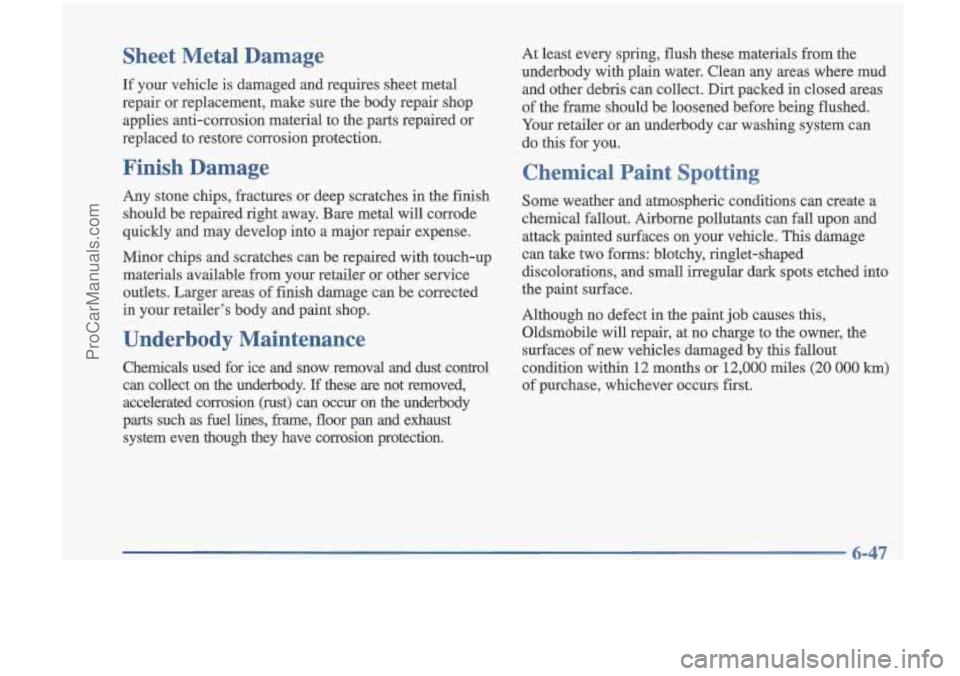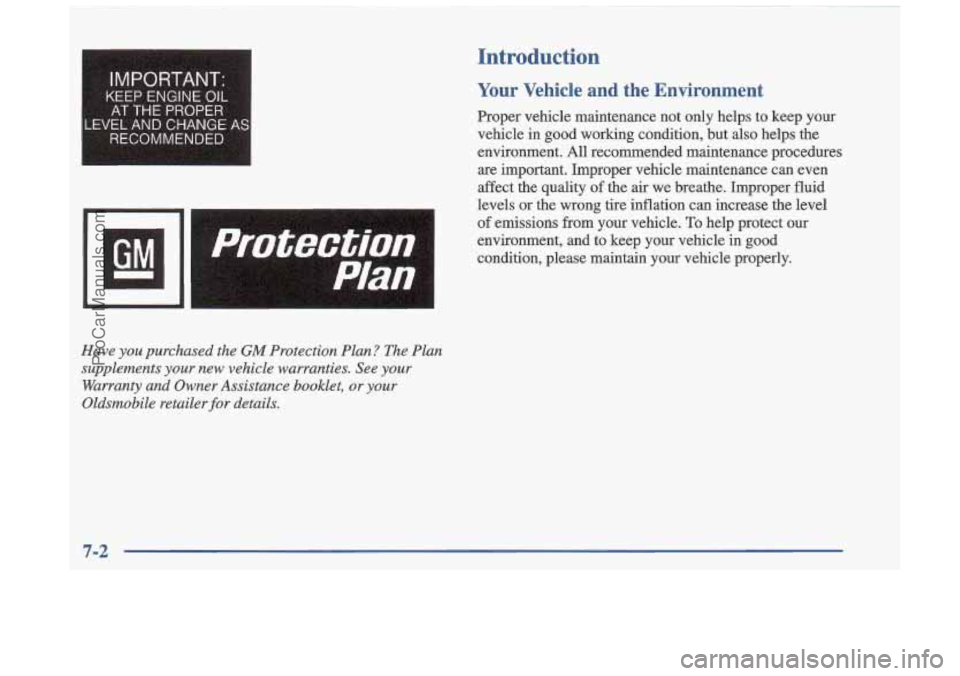1997 OLDSMOBILE CUTLASS maintenance
[x] Cancel search: maintenancePage 270 of 353

Sheet Metal Damage
If your vehicle is damaged and requires sheet metal
repair or replacement, make sure the body repair shop
applies anti-corrosion material to the parts repaired or
replaced to restore corrosion protection.
Finish Damage
Any stone chips, fractures or deep scratches in the finish
should be repaired right away. Bare metal will corrode
quickly and may develop into a major repair expense.
Minor chips and scratches can be repaired with touch-up
materials available from your retailer
or other service
outlets. Larger areas of finish damage can be corrected
in your retailer’s body and paint shop.
Underbody Maintenance
Chemicals used for ice and snow removal and dust control
can collect on the underbody.
If these are not removed,
accelerated corrosion (rust) can occur on the underbody
parts such
as fuel lines, frame, floor pan and exhaust
system even though they have corrosion protection.
At least every spring, flush these materials from the
underbody with plain water. Clean any areas where mud and other debris can collect.
Dirt packed in closed areas
of the frme should be loosened before being flushed.
Your retailer or an underbody car washing system can
do this for you.
Chemical Paint Spotting
Some weather and atmospheric conditions can create a
chemical fallout. Airborne pollutants can fall upon and
attack painted surfaces on your vehicle. This damage
can take two forms: blotchy, ringlet-shaped
discolorations, and small irregular dark spots etched into
the paint surface.
Although no defect in the paint job causes
this,
Oldsmobile will repair, at no charge to the owner, the
surfaces of new vehicles damaged by this fallout
condition within
12 months or 12,000 miles (20 000 km)
of purchase, whichever occurs first.
6-47
ProCarManuals.com
Page 281 of 353

’ 3100 Engine Specifications
VIN Engine Code ........................... M
Type .................................... V6
Displacement
........................ 3.1 Liters
Firing Order
...................... 1-2-3-4-5-6
Horsepower
............................. 155
Thermostat Temperature ........... 195°F (91°C)
Air Conditioning Refrigerants
Not all air conditioning refrigerants are the same.
If the air conditioning system in your vehicle needs
refrigerant, be sure the proper refrigerant is used.
If you’re not sure, ask your Oldsmobile retailer.
Normal Maintenance
Replacement Parts
Air Cleaner Element ......... AC Type A- 1279C
Engine Oil Filter ................ AC Type PF-47
Spark Plugs ..... AC Type 041-940 (Platinum Plug)
Gap:
0.060 inch (1.52 mm)
Windshield Wiper Blades
Driver’s Side ................. 22 inches (56 cm)
Passenger’s Side
............... 19 inches (48 cm)
Dimensions
Length ......... I ......... 192 inches (487.8 cm)
Width
................... 69.4 inches (176.3 cm)
Height
................... 56.4 inches (143.2 cm)
Wheelbase
................ 107 inches (27 1.9 crn)
Front Tread
................ .59 inches (149.9 cm)
Rear Tread
............... 59.3 inches (150s cm)
ProCarManuals.com
Page 284 of 353

Section 7 Maintenance Schedule
Owner Checks at Each Fuel Fill-up What to Check at Least Once a Month
What to Check at Least Twice a Year
What to Check at Least Once a Year
Periodic Maintenance Inspections
Recommended Fluids and Lubricants
Tips for Keeping Track
of Maintenance
A Place to Record Maintenance Procedures
This section covers
the maintenance required for your Oldsmobile. Your vehicle needs these services to retain its
safety, dependability and emission control performance.
7-2 Introduction to Your Maintenance Schedule
7-37
7-2
Your Vehicle and the Environment 7-37
7-3
How this Section is Organized
7-38
7-4 Using Your Maintenance Schedule 7-38
7-43
7-6 Long Trip/Highway Definition 7-43
7-5 Short Trip/City Intervals
7-42 7-5 Short Trip/City Definition 7-41
7-4 Selecting the Right Schedule for Your Vehicle
7-6 Long Trip/Highway Intervals
7-1
ProCarManuals.com
Page 285 of 353

-EVEL AND CHANGE AS
RECOMMENDED
Protection
Plan
Have you purchased the GM Protection Plan? The Plan
supplements
your new vehicle warranties. See your
Warranty and Owner Assistance booklet, or your
Oldsmobile retailer for details.
Introduction
Your Vehicle and the Environment
Proper vehicle maintenance not only helps to keep your
vehicle in good working condition, but also helps the environment. All recommended maintenance procedures
are important. Improper vehicle maintenance can even
affect the quality
of the air we breathe. Improper fluid
levels or the wrong tire inflation can increase the level
of emissions from your vehicle. To help protect our
environment, and to keep your vehicle in good
condition, please maintain
your vehicle properly.
ProCarManuals.com
Page 286 of 353

How This Section is Organized
The remainder of this section is divided into five parts:
“Part A: Scheduled Maintenance Services’’ shows
what to have done and how often. Some
of these
services can be complex,
so unless you are technically
qualified and have the necessary equipment, you should
let your retailer’s service department or another
qualified service ce-%r do these jobs.
Performing maintenance work on a vehicle can
be dangerous.
In trying to do some jobs, you can
be seriously injured.
Do your own maintenance
work only if you have the required know-how
and the proper tools and equipment for the
job.
If you have any doubt, have a qualified
technician do the work.
If you are skilled enough to do some work on your
vehicle, you will probably want
to get the service
information
GM publishes. See “Service and Owner
Publications” in the Index.
“Part B: Owner Checks and Services” tells
you what should be checked and when. It
also explains
what you can easily do to help keep your vehicle in good condition.
“Part C: Periodic Maintenance Inspections” explains
important inspections that your Oldsmobile retailer’s service department or another qualified service center
should perform.
“Part D: Recommended Fluids and Lubricants” lists
some products GM recommends to help keep your
vehicle properly maintained. These products, or their
equivalents, should be used whether you do the work
yourself or have it done.
“Part E: Maintenance Record” provides a place for
you to record the maintenance performed on your
vehicle. Whenever any maintenance is performed, be
sure to write it down in this part. This will help you
determine when your next maintenance should be done.
In addition, it is a good idea to keep your maintenance
receipts. They may be needed to qualify your vehicle for
warranty repairs.
7-3
ProCarManuals.com
Page 287 of 353

Part A: Scheduled Maintenance
Services
Using Your Maintenance Schedule
We at General Motors want to help you keep your
vehicle in good working condition. But we don’t know
exactly how you’ll drive
it. You may drive very short
distances only a few times a week. Or you may drive
long distances all the time in very hot, dusty weather.
You may use your vehicle in making deliveries. Or
you may drive it to work, to do errands or in many
other ways.
Because of all the different ways people use their GM
vehicles, maintenance needs vary. You may even need
more frequent checks and replacements than you’ll find
in the schedules in
this section. So please read this
section and note how you drive. If you have any
questions on how to keep your vehicle in good
condition, see your Oldsmobile retailer. The proper fluids and lubricants to use are listed
in Part D.
Make sure whoever services your vehicle uses these. All
parts should be replaced and all necessary repairs done
before you or anyone else drives the vehicle.
These schedules are for vehicles that:
carry passengers and cargo within recommended
limits. You will find these limits on your vehicle’s
Tire-Loading Information label. See “Loading Your
Vehicle” in the Index.
are driven on reasonable road surfaces within legal
driving limits.
use the recommended fuel. See “Fuel’’ in the Index.
Selecting the Right Schedule
First you’ll need to decide which of the two schedules is
right for your vehicle. Here’s how to decide which
schedule to follow:
This part tells you the maintenance services you should
have done
and when you should schedule them. If you
go to your retailer for your service needs, you’ll know
that GM-trained and supported service people will
perform the work using genuine GM parts.
ProCarManuals.com
Page 288 of 353

Maintenance Schedule
Short Trip/City Definition
Follow the Short Trip/City Maintenance Schedule if any
one of these conditions is true for your vehicle:
Most trips are less than 5 to 10 miles (8 to 16 km).
This is particularly important when outside
temperatures are below freezing.
0 Most trips include extensive idling (such as frequent
driving
in stop-and-go traffic).
Most trips are through dusty areas.
0 You frequently tow a trailer or use a carrier on top of
0 If the vehicle is used for delivery service, police, taxi
your vehicle.
or other commercial application.
One of the reasons you should follow this schedule if
you operate your vehicle under any of these conditions
is that these conditions cause engine oil
to break
down sooner
Short Trip/City Intervals
Every 3,000 Miles (5 000 km): Engine Oil and Filter
Change (or
3 months, whichever occurs first).
Every 6,000 Miles (10 000 km): Tire Rotation.
Every 15,000 Miles (25 000 km): Air Cleaner Filter
Inspection,
if driving in dusty conditions.
Every 30,000 Miles (50 000 km): Air Cleaner Filter
Replacement. Fuel Tank, Cap and Lines Inspection.
Every 50,000 Miles (83 000 km): Automatic Transaxle
Service (severe conditions only).
Every 60,000 Miles (100 000 km): Engine Accessory
Drive Belt Inspection.
Every 100,000 Miles (166 000 km): Spark Plug Wire
Inspection. Spark Plug Replacement.
Every 150,000 Miles (240 000 km): Cooling System
Service (or every
60 months, whichever occurs first).
These intervals only summarize maintenance services.
Be sure to follow the complete maintenance schedule
on
the following pages.
ProCarManuals.com
Page 289 of 353

Maintenance Schedule
Follow this maintenance schedule only if none of the
conditions from the Short TripKity Maintenance
Schedule
is true. Do not use this schedule if the vehicle
is used for trailer towing, driven in a dusty area or used
off paved roads. Use the Short TripKity schedule for
these conditions.
Driving a vehicle with a filly warmed engine under
highway conditions causes engine oil to break
down slowel:
Every 7,500 Miles (12 500 km): Engine Oil and Filter
Change (or every
12 months, whichever occurs fist).
Tire Rotation.
Every 30,000 Miles (50 000 km): Air Cleaner Filter
Replacement. Fuel Tank, Cap and Lines Inspection.
Every 50,000 Miles (83 000 km): Automatic Transaxle
Service (severe conditions only).
Every 60,000 Miles (100 000 km): Engine Accessory
Drive Belt Inspection.
Every 100,000 Miles (166 000 km): Spark Plug Wire
Inspection. Spark Plug Replacement.
Every 150,000 Miles (240 000 km): Cooling System
Service (or every
60 months, whichever occurs first).
These intervals only summarize maintenance services.
Be sure
to follow the complete maintenance schedule on
the following pages.
ProCarManuals.com